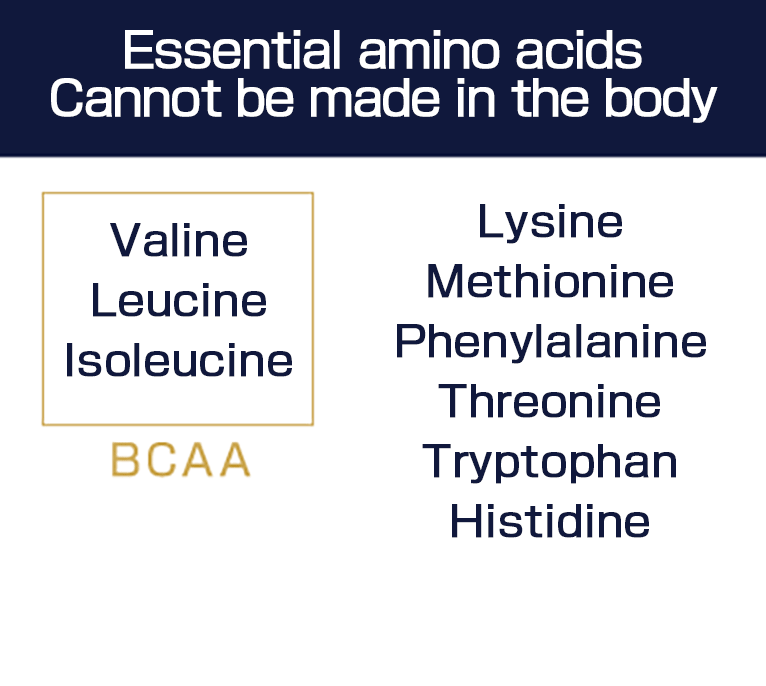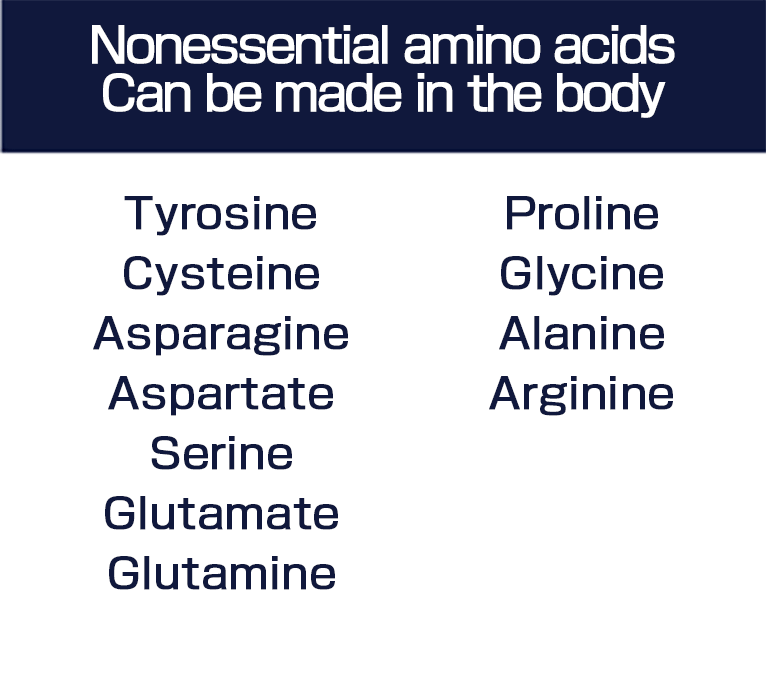Functional Amino Acids
in Sports
Click here>>

-

Amino acids are important for sports, but what are amino acids in the first place?
-

Twenty percent of the body is made up of protein. Muscles, skin, hair, nails, bones, and internal organs, as well as blood and hormones are composed of protein. These proteins consist of thousands to tens of thousands of amino acids. Such proteins comprise 20 kinds of amino acids.

-

These 20 kinds of amino acids can be classified into two groups:essential amino acids, which cannot be made in the body and must be obtained via diet, and nonessential amino acids, which can be made in the body.
Essential amino acids include three branched-chain amino acids known as BCAA (isoleucine, leucine, and valine).
-

I need to obtain amino acids as part of my diet. How often do I need them?
-

The proteins are constantly being remade in the body. Old proteins are degraded and replaced every day.
Since the balance is maintained by consuming the required protein every day, it is important to obtain an adequate amount from the diet.

-

I have to consume proteins every day. Is the recommended amount to be consumed the same for every person?
-

The recommended intake of protein for sportsperson/athletes ranges from 1.2 to 2.0 g per kilogram of body weight per day. For instance, with a bodyweight of 70 kg, the recommended amount would be 84 to 140 g per day. This is 1.3 to 2.0-fold higher than the recommended amount of protein for an average adult.It is very important for people who play sports to obtain a large amount of protein from their daily diet to keep their muscles sufficiently strong.
Recommended daily intake of protein

-

Okay, I know that protein is required. Is it okay to obtain protein from meat or fish when I need it?
-

Protein obtained from the diet cannot be absorbed as-is. Typically, it takes 3 to 4 hours for degradation into amino acids and subsequent absorption.
Since amino acids do not need to be digested, the time for absorption is approximately 30 minutes. Compared to proteins, amino acids are characterized by their immediate availability upon requirement.

-
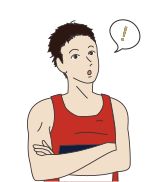
It seems that it is more convenient to consume amino acids than protein!
-

That’s right. It is also advantageous as the required amino acids are obtained in the necessary amount and at the necessary time.
By using amino acids, you can efficiently supply what you need. For example, if you want to eat 1g of BCAA, you need about 1/4 of a hamburger steak (patty) and the energy consumed is about 90 kcal. whereas with amino acids, you can take only 1g of BCAAs directly, which requires only 4kcal of energy.
Only the necessary amount of amino acids need to be consumed

-

It seems that there are certain advantages of utilizing amino acids.
What are the amino acids needed by people who exercise? -

BCAA (branched-chain amino acids)
Valine, leucine, and isoleucine are branched-chain amino acids (BCAA) that are important nutrients for sports. These amino acids are abundant in food such as tuna, skipjack tuna, chicken, beef, eggs, and milk.
BCAAs account for 40% of essential amino acids in human muscles and can be utilized as an energy source during exercise. Many reports have found that these have an effect on muscle function. -

How does it act on our muscles?
-

Ingestion of BCAAs increases the amount of protein that muscles produce after exercise and reduces muscle damage caused by exercise.
-

Many people experience muscle soreness after exercise. This soreness, particularly that on the day after exercise, can be alleviated by BCAAs.
-
-
BCAA may benefit those who engage in sports.
-

Leucine
One BCAA, leucine, is not only used to make muscle proteins combining with other essential amino acids,but also acts as a switch for the muscle protein synthesis.
-

Okay, now I know that BCAA and leucine are beneficial. Amino acids are interesting!
-

Other amino acids are also known that possess various functions. Let us take a look.
-
Glutamine
Of the 20 kinds of amino acids, glutamine is the most common amino acid.The body loses a lot of glutamine when it is stressed, such as during exercise.. In food, it is abundant in soybeans, wheat, fish, meat, eggs, etc.
Glutamine can also enhance the immune system and protect mucous membranes such as those lining the stomach and the intestines. -
Cystine
Another one of the 20 kinds of amino acids, cysteine is one of the 20 kinds of amino acids. Cystine is composed of two cysteine molecules bonded together. In food, it is abundant in chicken and other meats.
It helps protect the body from various stresses.
-
Alanine
It is one of the amino acids that can be converted into sugars and used as an energy source in the body. In food, in addition to fish and meat, it is abundant in many shellfish such as clams and freshwater clams.
It enhances glycogen storage from carbohydrates in the liver.
-
Proline
Similar to alanine, proline can be converted into sugar in the body and is one of the amino acids that can be used as an energy source. In food, it is abundant in soybeans, wheat, meat, fish, etc.
Summary
- ・Proteins that comprise 20% of the body are composed of 20 kinds of amino acids
- ・The 20 kinds of amino acids are classified as “essential amino acids” and “non-essential amino acids”
- ・As proteins are replaced in the body, it is important to consume them as a part of your daily diet
- ・Sportspersons should consume high amount of protein in their diet
- ・Amino acids are absorbed in 30 minutes as they are not needed to digestion
- ・Utilizing amino acids would imply that the necessary amino acids can be obtained at the right amount whenever required.

